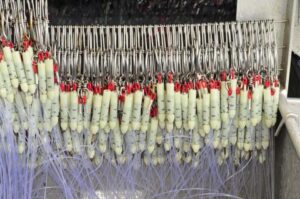Sliding Leads
WHAT ARE SLIDING LEADS?
Seabirds are at greatest risk of becoming hooked and drowned when foraging during the short period between when hooks leave the vessel, and when they sink beyond seabirds’ diving ranges. Sliding leads, also known as sliding weights, are used to increase the sink rate of branchlines in pelagic longline fisheries, placing baited hooks out of the range of diving seabirds more quickly.
Sliding leads are an alternative to leaded swivels, which can cause serious injury to crew as a result of fly-back caused by breaking lines. In the event of a line breaking under tension, sliding leads are designed to slide away from the crew, dampening the energy of the recoiling hook and reducing the likelihood of its flying back towards the vessel and causing injury.

Rigged Lumo Leads. Source: FishTek Marine
CURRENT RESEARCH & USE
Weighted branchlines are among the accepted measures required by the Regional Fisheries Management Organisation (RMFO) to reduce seabird bycatch in the High Seas. Studies have been conducted in Korean pelagic longline tuna fisheries, as well as pelagic longline vessels operating off of western Australian and southern Africa.
Trials conducted between 2013 and 2015 found that Lumo Leads – a type of sliding lead developed by Fishtek Marine – can increase sink rates of baited longlines without compromising fishing effort or crew safety.
This page was last updated on 12.02.21.
Interested in how this and other measures could mitigate bycatch in your fishery? Get in touch with us to collaborate or take part in a study.
